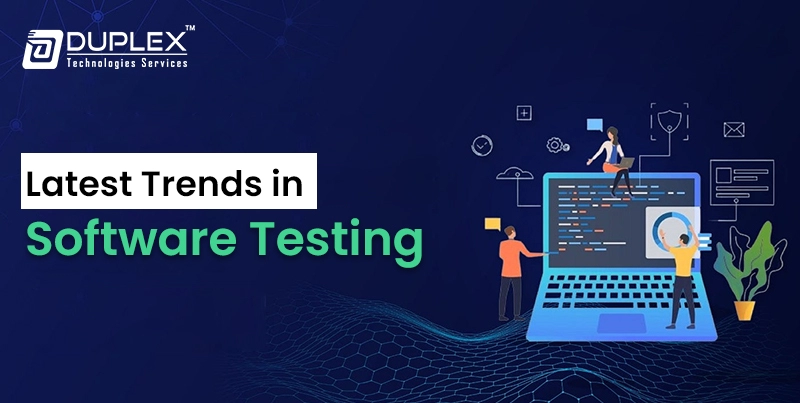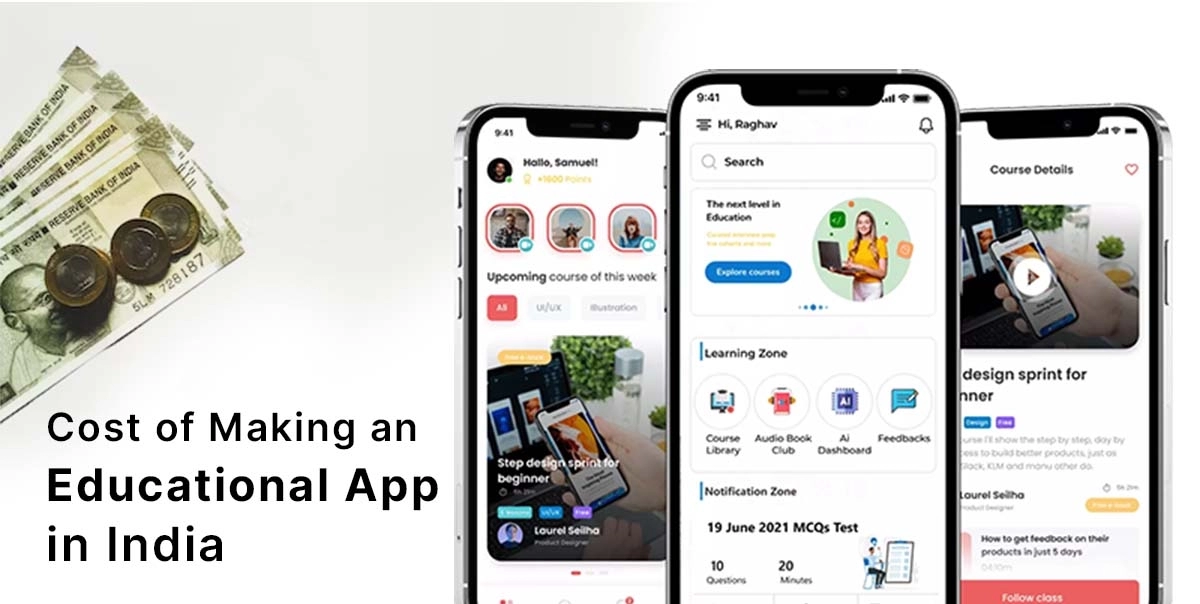Latest trends in software testing: boost the quality of software with latest trends | Software testing trends to enhance user experience | Duplex Technologies

Posted By : Ambesh Mishra, Posted Date : Sep 21, 2024
Introduction: latest trends in software testing
Today, we are going to discuss about the latest trends in software testing. In the present generation, software is one of the most important things that help businesses and organizations to move forward. However, as dependence on such software increases, it becomes important that the software used is high quality and reliable. Following the software testing trends is crucial to an application since it helps to locate possible problems or bugs and eliminate them to ensure that the user interface is optimal for the end user. New trends in software testing appear every year and it is crucial to be informed about them. Some of the current practice solutions include artificial intelligence and machine learning approaches to testing, DevOps integration, and cloud testing. Further, emerging areas such as cybersecurity testing, current emerging testing, test automation, and performance engineering. It is important to keep abreast of these trends, especially for anyone who is depending on software for their activities. So, let’s grab some in-depth details of the latest software testing trends.
Table of Contents
What are software testing trends?
Software testing means a process of checking whether a given software application or system meets its designed requirements and performs in a required manner. This means the critical reviewing of the software, where the reviewer provides feedback of the defects, errors, or bugs in the software and assurance that the software is performing optimally and is free from bugs. Software testing is the activity that is performed in order to verify the conformity to the defined requirements and to prevent the appearance of defects that may decrease software usability or lead to its failure. It is the final stage of the software development life cycle that is aimed at making sure that software developed is released to the market as adequate quality.
Benefits of following the latest software testing trends
Given below are the benefits of following the new trends in software testing:
Enhanced User Experience: Treading the trends such as performance engineering and usability testing makes the user interface smooth. This in turn results in enhanced customer satisfaction, customer loyalty, and therefore business profitability.
Reduced Costs: Adopting methods such as cloud-based testing and DevOps leads to low costs of testing and fewer testing requirements. This will in a way help businesses to manage their resources and financial ratios in a better manner.
Improved Test Efficiency: Following the latest trends in software testing such as automation and AI in testing helps in improving the testing speed and accuracy when in tune with current trends. This results in faster testing cycles, less manual intervention, and thereby higher efficiency.
Increased Security: The trends in cybersecurity testing help in safeguarding against new risks and weaknesses in the system. This means that the software applications are protected, any kind of data is safe from interference, and users’ confidence is maintained.
Better Quality: To minimize errors and bugs, the software testing trends should be as updated as possible to warrant high-quality software. This results in higher reliability, stability, and performance of the software applications in use.
Data-Driven Decision Making: Using new trends in software testing such as analytics and machine learning enhances how decisions will be made at specific times, especially when developing software. This helps the businesses to make informed decisions, find out areas that need their attention and improve how they operate to foster innovation.
Competitive Advantage: Adapting to the new trends shows dedication to change and differentiation from the rivals by businesses. This results in market share advancement, customer acquisition, and retention, hence enhancing business viability and stability.
Types of software testing trends
There are various latest software testing trends in the industry, some of which we have explained below:
1. Automated testing and DevOps implementation
DevOps is used when test automation is incorporated to increase flexibility and speed. Automated tests are performed constantly; therefore, the results, whether pass or fail, are provided immediately. In essence, these latest trends in software testing enable one to have a higher time of market and quality. It means that the development teams can participate in just the developmental work while the automation does the testing.
2. Cloud-based testing and containerization
Cloud-based testing, on the other hand, offers scalability and flexibility and is relatively cheaper. Containerization lowers errors because the conditions are standardized in the containers and do not differ from the test environment. There’s much to gain from adopting cloud-based testing, specifically in the integration, development, and delivery of agile applications. Following these software testing trends makes the testing processes efficient and does away with many of the supportive features.
3. Performance engineering and non-functional testing
These new trends in software testing include the assessment of performance and scalability with the necessary resources and techniques to ensure software dependability. Like any other type of testing, non-functional testing involves tests such as usability, security, and compatibility, among others. This form of testing identifies constraints, whereby it is ensuring that the software meets the needs of the user. Performance engineering increases the efficiency of the software people operate.
4. Agile and continuous testing
Test models based on agility include continuous testing and delivering feedback and results within a short period. Continuous testing in Agile development is in harmony with the improvement of agility as it offers a shorter time-to-market. The opposite of this is agile testing, which is more focused on flexibility, working in teams, and fulfilling customer needs. These latest trends in software testing can ensure that the software complies with new regulations or with the expected requirements from the users.
5. Artificial Intelligence (AI) and Machine Learning (ML)
AI and ML bring the software testing trends to a new, higher level of automation and enhanced testing. Such technological applications mean that one is able to detect the flaws, establish when the maintenance work is needed, and perform effective tests. It indicates that machine learning algorithms improve the outcome of the test and reduce false positives and false negatives. This is because AI-based testing is efficient in the processes that are embarked upon in that it not only enhances their speed but also enhances the accuracy thereof.
6. Security testing and automation
Security testing validates the assurance of software and other things, like the container threat. Security automation is the act of combining security testing into the development process. It also ensures steady monitoring of threats, timely identification, as well as risk mitigation, and compliance with legislation. Secured testing is required for data protection and to gain the trust of customers and users over the network.
7. Blockchain testing
Blockchain testing is about ascertaining that decentralized applications meet specific security, scale, and performance requirements. Each of the test activities performed here involves testers that are well familiar with smart contracts, transactions, and network integrity. It is imperative to note that blockchain testing is designed to identify defects to ensure data is secure in the blocks and when shared. These latest trends in software testing assist in teaching the set procedures and regulations in the right manner.
8. API testing and microservices testing
API testing inspects the entire communication of the microservices as well as the data exchange and integration. Microservices testing focuses primarily on a single service’s function, performance, and security. The API test case contains areas of authentication, authorization, and data validity tests. This new trend in software testing ensures that microservice architecture is assured, elastic, and secure.
9. Quantum computing and testing
The software testing industry is revolutionized by the introduction of quantum computing since it has the ability to run large test cases with ease and in less time. This software testing trends partially solves the problem of efficient testing for optimality of specific algorithms as for the time and resources. Quantum computing enhances the aspect of simulation based testing by delivering better results. It means that one can test broad systems and still create room for stability and effectiveness.
10. Low-code and no-code testing
Low-code and no-code testing enable non-technical users to build tests independently of developers. GUIs are easier to use for designing, amending, and executing tests than using only code. Low-code and no-code testing results in faster testing cycles and quick time to market. This in regards to the involvement of the business users to do testing to make it fit the requirements in the field.
Conclusion
software testing industry while underlying the aspects of testing as being crucial to providing quality software. This is because, with the increased use of software in people’s daily activities, it becomes so important that software be tested properly. These software testing trends in the form of AI testing, blockchain testing, and continuous testing show how the industry progresses rather than only maintaining the highest standard. By adopting these latest software testing trends, organizations would love to see that software is developed with certain qualities: dependability and security. To guarantee the safety of the applications, in order to exclude as many possible erroneous situations as possible, and in order to provide the users’ data, the testing should be a regular procedure. This is especially important in today’s software-oriented environment, where an organization has to be able to improve on previous performance and innovate.




















































































